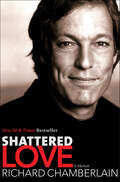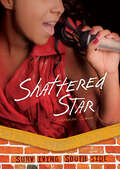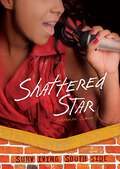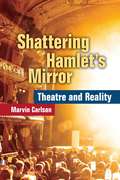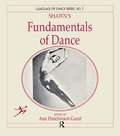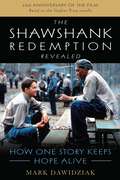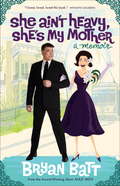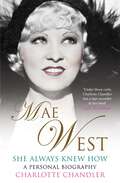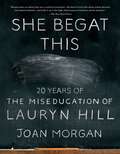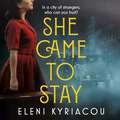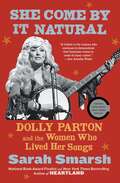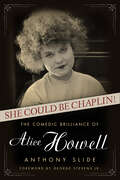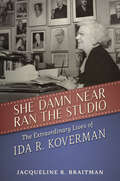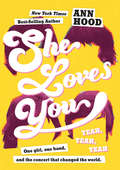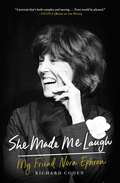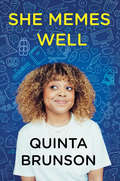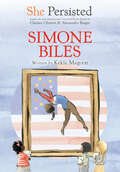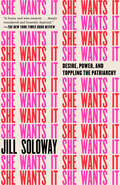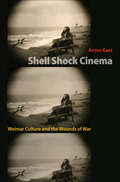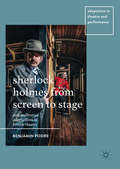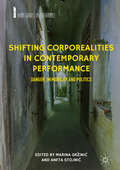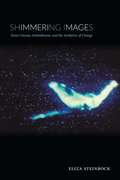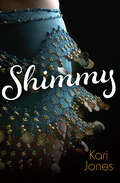- Table View
- List View
Shattered Love: A Memoir
by Richard ChamberlainIn Shattered Love, Richard Chamberlain poignantly recounts his lifelong struggle to find happiness. Tracing a fascinating path over his meteoric rise to success, he chronicles his struggle to come to terms with his own imperfections, his growing desire to be honest about his sexual orientation, and his yearning to live with an open heart. And along the way he imparts the lessons he has learned about overcoming our own self–imposed obstacles to happiness.
Shattered Star (Surviving Southside Ser.)
by Charnan SimonWhat's the price of fame? Cassie is the best singer in Southside High's Glee Club and dreams of being famous. She skips school to try out for a national talent competition. But her hopes sink when she sees the line. Then a talent agent shows up out of nowhere. Cassie is flattered to hear she has "the look" he wants. Soon, she is lying and missing rehearsal to meet with him. And he's asking her for more each time. How far will Cassie go for her shot at fame?
Shattered Star (Surviving Southside)
by Charnan SimonWhat's the price of fame? Cassie is the best singer in Southside High's Glee Club and dreams of being famous. She skips school to try out for a national talent competition. But her hopes sink when she sees the line. Then a talent agent shows up out of nowhere. Cassie is flattered to hear she has "the look" he wants. Soon, she is lying and missing rehearsal to meet with him. And he's asking her for more each time. How far will Cassie go for her shot at fame?
Shattering Hamlet's Mirror: Theatre and Reality
by Marvin CarlsonTheatrical playing, Hamlet famously averred, holds a mirror up to nature. But unlike the reflections in the mirror, the theater's images are composed of real objects, most notably bodies, that have an independent existence outside the world of reflection. Throughout Western theater history there have been occasions when the reality behind the illusion was placed on display. In recent years theaters in Europe and North America have begun calling attention to the real in their work--presenting performers who did not create characters and who may not even have been actors, but who appeared on stage as themselves; texts created not by dramatic authors but drawn from real life; and real environments sometimes shared by actors and performers and containing real elements accessible to both. These practices, argues Marvin Carlson, constitute a major shift in the practical and phenomenological world of theater, and a turning away from mimesis, which has been at the heart of the theater since Aristotle. Shattering Hamlet's Mirror: Theatre and Reality examines recent and contemporary work by such groups as Rimini Protokoll, Societas Raffaelo Sanzio, the Gob Squad, Nature Theatre of Oklahoma, and Foundry Theatre, while revealing the deep antecedents of today's theater, placing it in useful historical perspective. While many may consider it a post-postmodern phenomenon, the "theater of the real," as it turns out, has very deep roots.
Shawn's Fundamentals of Dance (Language of Dance)
by Ann Hutchinson GuestFirst Published in 1988. Routledge is an imprint of Taylor & Francis, an informa company.
Shawshank Redemption Revealed: How One Story Keeps Hope Alive
by Mark DawidziakA 25th anniversary history and celebration of The Shawshank Redemption, one of the most cherished American films of the late twentieth century and one of the finest movies made from a Stephen King story. The movie not only boasts a great story, it has a great backstory, starting with the dollar deal that eventually led King and co-stars Tim Robbins and Morgan Freeman to put their trust in a largely untested director making his first feature film. Although the film received mostly positive reviews on its release in September 1994, the box office was disappointing and it failed to win many awards. But as Andy tells Red in the film, &“no good thing ever dies.&” The movie found new life, reaching an ever-growing audience on cable and home video (through word of mouth, it became one of the top-rented movies of 1995). Each year, The Shawshank Redemption rises in polls asking film fans to name their favorite movies. It has become nothing less than this generation&’s The Grapes of Wrath, an inspiring story about keeping hope alive in bleak times and under the most horrendous conditions.
She Ain’t Heavy, She’s My Mother: A Memoir
by Bryan BattGayle Batt is the kind of lady who throws elegant cocktail parties while wearing layers of silk chiffon, dripping pearls, and eight months' pregnant. She is the kind of woman who says "anyhoo" and calls everyone "Dahlin'" or a special pet name. With hair, makeup, and nails always done to perfection, she triumphs rather than crumbles when infidelity, alcoholism, cancer, or any form of adversity attempts to shatter her family. Endearing and enduring, Gayle is a big-hearted, strong-willed true Southern belle-and she taught her son everything he knows about being a man. In She Ain't Heavy, She's My Mother, Bryan Batt, the actor who plays Sal Romano on the Emmy, Golden Globe, and Peabody Award-winning Mad Men, chronicles his life-and his mother's supportive presence in it. From growing up gay below the Mason-Dixon Line to landing principal roles on Broadway (his first was on roller skates playing a singing and dancing boxcar in Starlight Express!) and later on the picture-perfect sets of TV's Mad Men, to opening the ever-popular Hazelnut boutique in his hometown of New Orleans with his partner, Bryan weaves a touching and hilarious story of the South, showbiz, and an unshakable bond between mother and son.
She Always Knew How: Mae West, a Personal Biography
by Charlotte ChandlerIn She Always Knew How, her wonderful new biography of legendary actress Mae West, acclaimed biographer Charlotte Chandler draws on a series of interviews she conducted with the star just months before her death in 1980. From their first meeting, where West held out a diamond-covered hand in greeting and lamented her interviewer's lack of jewels, to their farewell, where the star was still gamely offering advice on how to attract men, Mae West and Charlotte Chandler developed a warm rapport that glows on every page of this biography. Actress, playwright, screenwriter, and iconic sex symbol Mae West was born in New York in 1893. She created a scandal -- and a sensation -- on Broadway with her play Sex in 1926. Convicted of obscenity, she was sentenced to ten days in prison. She went to jail a convict and emerged a star. Her next play, Diamond Lil, was a smash, and she would play the role of Diamond Lil in different variations for virtually her entire film career. In Hollywood she played opposite George Raft, Cary Grant (in one of his first starring roles), and W. C. Fields, among others. She was the number one box-office attraction during the 1930s and saved Paramount Studios from bankruptcy. Her films included some notorious one-liners -- which she wrote herself -- that have become part of Hollywood lore: from "too much of a good thing can be wonderful" to "When I'm good, I'm very good. When I'm bad, I'm better." Her risqué remarks got her banned from radio for a dozen years, but behind the clever quips was Mae's deep desire, decades before the word "feminism" was in the news, to see women treated equally with men. She saw through the double standard of the time that permitted men to do things that women would be ruined for doing. Her cause was sexual equality, and she was shrewd enough to know that it was perhaps the ultimate battleground, the most difficult cause of all. In addition to her extensive interviews of Mae West, Chandler also spoke with actors and directors who worked with and knew the star, the man with whom she lived for the last twenty-seven years of her life, as well as her closest assistant at the end of her life. Their comments and insights enrich this fascinating book. She Always Knew How captures the voice and spirit of this unique actress as no other biography ever has.
She Begat This: 20 Years of The Miseducation of Lauryn Hill
by Joan MorganCelebrate the twentieth anniversary of the acclaimed and influential debut album The Miseducation of Lauryn Hill with this eye-opening and moving exploration of Lauryn Hill and her remarkable artistic legacy.Released in 1998, Lauryn Hill’s first solo album is often cited by music critics as one of the most important recordings in modern history. Artists from Beyoncé to Nicki Minaj to Janelle Monáe have claimed it as an inspiration, and it was recently included in the National Recording Registry by the Library of Congress, as well as named the second greatest album by a woman in history by NPR (right behind Joni Mitchell’s Blue). Award-winning feminist author and journalist Joan Morgan delivers an expansive, in-depth, and heartfelt analysis of the album and its enduring place in pop culture. She Begat This is both an indelible portrait of a magical moment when a young, fierce, and determined singer-rapper-songwriter made music history and a crucial work of scholarship, perfect for longtime hip-hop fans and a new generation of fans just discovering this album.
She Came to Stay: The debut novel from the author of THE UNSPEAKABLE ACTS OF ZINA PAVLOU, a BBC2 Between the Covers pick
by Eleni KyriacouA story of friendship, family, love and loss set against the grimy and glittering streets of fifties Soho. For fans of Kate Furnivall and Rachel Rhys.In a city of strangers, who can you trust?London, 1952. Dina Demetriou has travelled from Cyprus for a better life. She's certain that excitement, adventure and opportunity are out there, waiting - if only she knew where to look.Her passion for clothes and flair for sewing land her a job repairing the glittering costumes at the notorious Pelican Revue. It's here that she befriends the mysterious and beautiful Bebba.With her bleached-blonde hair and an appetite for mischief, Bebba is like no Greek Dina has ever met before. She guides Dina around the fashionable shops, bars and clubs of Soho, and Dina finally feels life has begun.But Bebba has a secret. And as thick smog brings the city to a standstill, the truth emerges with devastating results. Dina's new life now hangs by a thread. What will be left when the fog finally clears? And will Dina be willing to risk everything to protect her future?(P) 2020 Hodder & Stoughton Ltd
She Come By It Natural: Dolly Parton and the Women Who Lived Her Songs
by Sarah SmarshIn this Time Top 100 Book of the Year, the National Book Award finalist and New York Times bestselling author of Heartland &“analyzes how Dolly Parton&’s songs—and success—have embodied feminism for working-class women&” (People). Growing up amid Kansas wheat fields and airplane factories, Sarah Smarsh witnessed firsthand the particular vulnerabilities—and strengths—of women in working poverty. Meanwhile, country songs by female artists played in the background, telling powerful stories about life, men, hard times, and surviving. In her family, she writes, &“country music was foremost a language among women. It&’s how we talked to each other in a place where feelings aren&’t discussed.&” And no one provided that language better than Dolly Parton. In this &“tribute to the woman who continues to demonstrate that feminism comes in coats of many colors,&” Smarsh tells readers how Parton&’s songs have validated women who go unheard: the poor woman, the pregnant teenager, the struggling mother disparaged as &“trailer trash.&” Parton&’s broader career—from singing on the front porch of her family&’s cabin in the Great Smoky Mountains to achieving stardom in Nashville and Hollywood, from &“girl singer&” managed by powerful men to self-made mogul of business and philanthropy—offers a springboard to examining the intersections of gender, class, and culture. Infused with Smarsh&’s trademark insight, intelligence, and humanity, this is &“an ambitious book&” (The New Republic) about the icon Dolly Parton and an &“in-depth examination into gender and class and what it means to be a woman and a working-class hero that feels particularly important right now&” (Refinery29).
She Could Be Chaplin!: The Comedic Brilliance of Alice Howell (Hollywood Legends Series)
by Anthony SlideAlice Howell (1886-1961) is slowly gaining recognition and regard as arguably the most important slapstick comedienne of the silent era. This new study, the first book-length appreciation, identifies her place in the comedy hierarchy alongside the best-known of silent comediennes, Mabel Normand. Like Normand, Howell learned her craft with Mack Sennett and Charlie Chaplin. Beginning her screen career in 1914, Howell quickly developed a distinctive style and eccentric attire and mannerisms, successfully hiding her good looks, and was soon identified as the "Female Charlie Chaplin."Howell became a star of comedy shorts in 1915 and continued her career through 1928 and the advent of sound in film. While she is today recognized as a pioneering female filmmaker, during her career she never expressed much interest in her work, seeing it only as a means to an end, with her income carefully invested in real estate. It has taken many years for her to gain her rightful place in film history, not only as a comedienne, but also as matriarch of a prominent American family that includes son-in-law and director George Stevens and grandson George Stevens Jr., founder of the American Film Institute and the Kennedy Center Honors, who provides a foreword.
She Damn Near Ran the Studio: The Extraordinary Lives of Ida R. Koverman (Hollywood Legends Series)
by Jacqueline R. BraitmanBest known as the woman who “ran MGM,” Ida R. Koverman (1876–1954) served as talent scout, mentor, executive secretary, and confidant to American movie mogul Louis B. Mayer for twenty-five years. She Damn Near Ran the Studio: The Extraordinary Lives of Ida R. Koverman is the first full account of Koverman’s life and the true story of how she became a formidable politico and a creative powerhouse during Hollywood’s Golden Era. For nearly a century, Koverman’s legacy has largely rested on a mythical narrative while her more fascinating true-life story has remained an enduring mystery—until now. This story begins with Koverman’s early years in Ohio and the sensational national scandal that forced her escape to New York where she created a new identity and became a leader among a community of women. Her second incarnation came in California where she established herself as a hardcore political operative challenging the state’s progressive impulse. During the Roaring Twenties, she was a key architect of the Southland’s conservative female-centric partisan network that refashioned the course of state and national politics and put Herbert Hoover in the White House. As “the political boss of Los Angeles County,” she was the premiere matchmaker in the courtship between Hollywood and national partisan politics, which, as Mayer’s executive secretary, was epitomized by her third incarnation as “one of the most formidable women in Hollywood,” whose unparalleled power emanated from her unique perch inside the executive suite of Metro-Goldwyn-Mayer. Free to adapt her managerial skills and political know-how on behalf of the studio, she quickly drew upon her artistic sensibilities as a talent scout, expanding MGM’s catalog of stars and her own influence on American popular culture. Recognized as “one of the invisible power centers in both MGM and the city of Los Angeles,” she nurtured the city’s burgeoning performing arts by fostering music and musicians and the public financing of them. As the “lioness” of MGM royalty, Ida Koverman was not just a naturalized citizen of the Hollywood kingdom; at times during her long reign, she “damn near ran the studio.”
She Kept Dancing: The True Story of a Professional Dancer with a Limb Difference
by Sydney Mesher Catherine LaudoneThis warm and inviting picture book, cowritten with Catherine Laudone and brightly illustrated by Natelle Quek, takes young readers along on Sydney’s journey—through the joyous ups as well as the crushing downs—and tells the story of how through it all, she kept dancing.No two dances were the same. Each one was beautiful because it was different—just like how Sydney’s body was also beautiful because it was different.Sydney Mesher was born with ten toes and five fingers. But it was her toes that her mom noticed first. "I can tell she’s going to be a dancer," she said.And it turned out Mom was right—after years of hard work, Sydney eventually danced her way onto the famous stage of Radio City Music Hall, becoming the first Rockette with a visible disability.
She Loves You (Yeah, Yeah, Yeah)
by Ann Hood"Filled with love, hope, and longing, this is a novel for readers of all ages." - Holly Goldberg Sloan <P><P>Bestselling author Ann Hood crafts a funny, heartfelt story of a girl growing up in the heart of Beatlemania. <P><P>The year is 1966. The Vietnam War rages overseas, the Beatles have catapulted into stardom, and twelve-year-old Rhode Island native Trudy Mixer is not thrilled with life. Her best friend, Michelle, has decided to become a cheerleader, everyone at school is now calling her Gertrude (her hated real name), and the gem of her middle school career, the Beatles fan club, has dwindled down to only three other members--the least popular kids at school. <P><P>And at home, her workaholic father has become even more distant.Determined to regain her social status and prove herself to her father, Trudy looks toward the biggest thing happening worldwide: the Beatles. She is set on seeing them in Boston during their final world tour--and meeting her beloved Paul McCartney. So on a hot August day, unknown to their families, Trudy and crew set off on their journey, each of them with soaring hopes for what lies ahead. <P><P>In her signature prose, Hood crafts an extraordinary story of growing up, making unexpected connections, and following your dreams even as the world in front of you--and the world at large--is changing too fast.
She Made Me Laugh: My Friend Nora Ephron
by Richard M. Cohen“A very personal remembrance of Nora Ephron’s life and loves, and her ups and downs” (USA TODAY) by her long-time and dear friend Richard Cohen in a hilarious, blunt, raucous, and poignant recollection of their decades-long friendship.Nora Ephron (1941–2012) was a phenomenal personality, journalist, essayist, novelist, playwright, Oscar-nominated screenwriter, and movie director (Sleepless in Seattle; You’ve Got Mail; When Harry Met Sally; Heartburn; Julie & Julia). She wrote a slew of bestsellers (I Feel Bad About My Neck: And Other Thoughts on Being a Woman; I Remember Nothing: And Other Reflections; Scribble, Scribble: Notes on the Media; Crazy Salad: Some Things About Women). She was celebrated by Hollywood, embraced by literary New York, and adored by legions of fans throughout the world. Award-winning journalist Richard Cohen, wrote this about She Made Me Laugh: “I call this book a third-person memoir. It is about my closest friend, Nora Ephron, and the lives we lived together and how her life got to be bigger until, finally, she wrote her last work, the play, Lucky Guy, about a newspaper columnist dying of cancer while she herself was dying of cancer. I have interviewed many of her other friends—Mike Nichols, Tom Hanks, Steven Spielberg, Meryl Streep, Arianna Huffington—but the book is not a name-dropping star turn, but an attempt to capture a remarkable woman who meant so much to so many other women.” With “the nuanced perspective of a confidant” (The Washington Post), She Made Me Laugh “is a fine tribute to a fascinating woman” (Houston Chronicle): “Nora would be pleased” (People, “Book of the Week”).
She Memes Well: Essays
by Quinta Brunson&“In She Memes Well, Quinta gives more than a peek behind the curtain. She invites us in, lets us poke around and offers a balm for our aching souls. She moves beyond the jokes into something much deeper, something we may not recognize we need. She is the friend, sister, lover, cool co-worker we all wished we had.&”—Gabrielle Union, actress and New York Times bestselling author of We&’re Going to Need More Wine From comedian Quinta Brunson comes a deeply personal and funny collection of essays about trying to make it when you're struggling, the importance of staying true to your roots, and how she's redefined humor online. Quinta Brunson is a master at breaking the internet. Before having any traditional background in media, her humorous videos were the first to go viral on Instagram&’s platform. From there, Brunson&’s wryly observant POV helped cement her status in the comedy world at large, with roles on HBO, Netflix, ABC, Adult Swim, BuzzFeed, the CW, and Comedy Central. Now, Brunson is bringing her comedic chops to the page in She Memes Well, an earnest, laugh-out-loud collection about this unusual road to notoriety. In her debut essay collection, Quinta applies her trademark humor and heart to discuss what it was like to go from a girl who loved the World Wide Web to a girl whose face launched a thousand memes. With anecdotes that range from the ridiculous—like the time she decided to go clubbing wearing an outfit she describes as "Gary Coleman meets metrosexual pirate"—to more heartfelt material about her struggles with depression, Quinta's voice is entirely authentic and eminently readable. With its intimate tone and hilarious moments, She Memes Well will make you feel as if you're sitting down with your chillest, funniest friend.
She Persisted: Simone Biles (She Persisted)
by Kekla Magoon Chelsea ClintonInspired by the #1 New York Times bestseller She Persisted by Chelsea Clinton and Alexandra Boiger, a chapter book series about women who spoke up and rose up against the odds--including Simone Biles!Simone Biles didn&’t always have it easy as a child. When her birth mother was no longer able to take care of her and her siblings, they moved in with her grandparents. But she always loved to run, jump, and bounce around. After trying gymnastics for the first time on a field trip at age six, Simone continued with the sport, working hard and facing many challenges along the way. Eventually, she reached a professional level, competing in world championships and at the Olympics. She kept competing and persisted, going on to become the most decorated US gymnast of all time. She also used her fame to speak up on important issues and to help other people. Through it all, she inspired kids everywhere to follow their dreams.In this chapter book biography by NAACP Image Award-winning author and Coretta Scott King Honor recipient Kekla Magoon, readers learn about the amazing life of Simone Biles--and how she persisted. Complete with an introduction from Chelsea Clinton, black-and-white illustrations throughout, and a list of ways that readers can follow in Simone Biles's footsteps and make a difference! A perfect choice for kids who love learning and teachers who want to bring inspiring women into their curriculum.And don&’t miss out on the rest of the books in the She Persisted series, featuring so many more women who persisted, including Florence Griffith Joyner, Ruby Bridges, Diana Taurasi, and more!
She Wants It: Desire, Power, and Toppling the Patriarchy
by Jill SolowayIn this poignant memoir of personal transformation, Jill Soloway takes us on a patriarchy-toppling emotional and professional journey. When Jill’s parent came out as transgender, Jill pushed through the male-dominated landscape of Hollywood to create the groundbreaking and award-winning Amazon TV series Transparent. Exploring identity, love, sexuality, and the blurring of boundaries through the dynamics of a complicated and profoundly resonant American family, Transparent gave birth to a new cultural consciousness. While working on the show and exploding mainstream ideas about gender, Jill began to erase the lines on their own map, finding their voice as a director, show creator, and activist. She Wants It: Desire, Power, and Toppling the Patriarchy moves with urgent rhythms, wild candor, and razor-edged humor to chart Jill’s evolution from straight, married mother of two to identifying as queer and nonbinary. This intense and revelatory metamorphosis challenges the status quo and reflects the shifting power dynamics that continue to shape our collective worldview. With unbridled insight that offers a rare front seat to the inner workings of the #metoo movement and its aftermath, Jill captures the zeitgeist of a generation with thoughtful and revolutionary ideas about gender, inclusion, desire, and consent.
Shell Shock Cinema: Weimar Culture and the Wounds of War
by Anton KaesHow war trauma haunted the films of Weimar GermanyShell Shock Cinema explores how the classical German cinema of the Weimar Republic was haunted by the horrors of World War I and the the devastating effects of the nation's defeat. In this exciting new book, Anton Kaes argues that masterworks such as The Cabinet of Dr. Caligari, Nosferatu, The Nibelungen, and Metropolis, even though they do not depict battle scenes or soldiers in combat, engaged the war and registered its tragic aftermath. These films reveal a wounded nation in post-traumatic shock, reeling from a devastating defeat that it never officially acknowledged, let alone accepted.Kaes uses the term "shell shock"—coined during World War I to describe soldiers suffering from nervous breakdowns—as a metaphor for the psychological wounds that found expression in Weimar cinema. Directors like Robert Wiene, F. W. Murnau, and Fritz Lang portrayed paranoia, panic, and fear of invasion in films peopled with serial killers, mad scientists, and troubled young men. Combining original close textual analysis with extensive archival research, Kaes shows how this post-traumatic cinema of shell shock transformed extreme psychological states into visual expression; how it pushed the limits of cinematic representation with its fragmented story lines, distorted perspectives, and stark lighting; and how it helped create a modernist film language that anticipated film noir and remains incredibly influential today.A compelling contribution to the cultural history of trauma, Shell Shock Cinema exposes how German film gave expression to the loss and acute grief that lay behind Weimar's sleek façade.
Sherlock Holmes from Screen to Stage
by Benjamin PooreThis book investigates the development of Sherlock Holmes adaptations in British theatre since the turn of the millennium. Sherlock Holmes has become a cultural phenomenon all over again in the twenty-first century, as a result of the television series Sherlock and Elementary, and films like Mr Holmes and the Guy Ritchie franchise starring Robert Downey Jr. In the light of these new interpretations, British theatre has produced timely and topical responses to developments in the screen Sherlocks' stories. Moreover, stage Sherlocks of the last three decades have often anticipated the knowing, metafictional tropes employed by screen adaptations. This study traces the recent history of Sherlock Holmes in the theatre, about which very little has been written for an academic readership. It argues that the world of Sherlock Holmes is conveyed in theatre by a variety of games that activate new modes of audience engagement.
Shibata Renzaburō and the Reinvention of Modernism in Postwar Japanese Popular Literature (East Asian Popular Culture)
by Artem VorobievShibata Renzaburō and the Reinvention of Modernism in Postwar Japanese Popular Literature explores the life and work of Shibata Renzaburō (柴田錬三郎, 1917–1978), the author of adventure and historical novels who was instrumental in reinvigorating popular Japanese literature in the postwar period. This book considers postwar Japanese society through the prism of Shibata’s writing, exploring how the postwar period under SCAP Occupation influenced Shibata’s writing and generated the extraordinary popularity of samurai fiction in the postwar era at large. Through the use of a nihilistic warrior, Nemuri Kyōshirō, and other samurai characters, Shibata Renzaburō addresses important social issues of the day, such as the trauma of defeat, postwar reconstruction, and the attending societal ills and neuroses, while keeping his literature entertaining and easy to read, which ensured its mass appeal in postwar Japan.
Shifting Corporealities in Contemporary Performance: Danger, Im/mobility And Politics (Avant-gardes In Performance)
by Marina Gržinić Aneta StojnićThis book investigates how contemporary artistic practices engage with the body and its intersection with political, technological, and ethical issues. Departing from the relationship between corporeality and performing arts (such as theater, dance, and performance), it turns to a pluriversal understanding of embodiment that resides in the extra violent conditions of contemporary global necro-capitalism in order to conduct a thorough analysis that goes beyond arts and culture. It brings together theoretical academic texts by established and emerging scholars alike, exposing perspectives form different fields (philosophy, cultural studies, performance studies, theater studies, and dance studies) as well as from different geopolitical contexts. Through a series of thematic clusters, the study explores the reactivation of the body as a site of a new meaning-making politics.
Shimmering Images: Trans Cinema, Embodiment, and the Aesthetics of Change
by Eliza SteinbockIn Shimmering Images Eliza Steinbock traces how cinema offers alternative ways to understand gender transitions through a specific aesthetics of change. Drawing on Barthes's idea of the “shimmer” and Foucault's notion of sex as a mirage, the author shows how sex and gender can appear mirage-like on film, an effect they label shimmering. Steinbock applies the concept of shimmering—which delineates change in its emergent form as well as the qualities of transforming bodies, images, and affects—to analyses of films that span time and genre. These include examinations of the fantastic and phantasmagorical shimmerings of sex change in Georges Méliès's nineteenth-century trick films and Lili Elbe's 1931 autobiographical writings and photomontage in Man into Woman. Steinbock also explores more recent documentaries, science fiction, and pornographic and experimental films. Presenting a cinematic philosophy of transgender embodiment that demonstrates how shimmering images mediate transitioning, Steinbock not only offers a corrective to the gender binary orientation of feminist film theory; they open up new means to understand trans ontologies and epistemologies as emergent, affective, and processual.
Shimmy (Orca Limelights)
by Kari JonesLila has always wanted a career in belly dance, so she is thrilled when she is invited to join Dana Sajala’s competitive and prestigious studio. But dancing at the new studio isn’t quite what she expected. Dana Sajala is a tough teacher, and Lila finds the constant criticism stressful. On top of that, Lila misses the dancers from her old troupe, and a rift is developing between her and her best friend, Angela, who is not altogether sympathetic to Lila’s struggles. Lila has always loved belly dance—the music, the costumes, the choreography—but when she realizes that none of it is as much fun as it used to be, she starts to question whether she has made the right choice. This short novel is a high-interest, low-reading level book for middle-grade readers who are building reading skills, want a quick read or say they don’t like to read!
